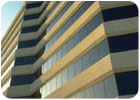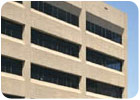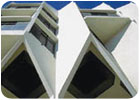
I received an odd email the other day from a company located in a town whose name I can't pronounce-somewhere in India. They had found me through Walls & Ceilings. The e-mail was an order for what looked like enough EIFS panels to cover the Pentagon. Their shopping list included dimensions and colors and all sorts of notes written by someone whose native tongue was clearly not English. There was even one drawing.
They were looking for a price. I ended up talking with them on the phone (they we nice enough to call me and not vice versa) after I e-mailed them that I don't make panels and that panels are not off-the-shelf items. After I educated them a bit more about panels, they decided to rethink their EIFS panel plans and bought a couple of my EIFS books. Now Mahatma and his buddies call me "Throbbet."

Panel talk
I get a lot of inquiries about panels. People overseas seem especially interested in them. Since in many countries the lightweight types of wall systems we commonly use in North America are not the norm (concrete and masonry are much more common), panels seem to be an ideal, simple solution. The thing about panels that people new to panels usually do not "get" is that they are not really as simple as they seem and there are a lot of aspects to using panels that need attention in order for using them to make sense. This month's article is a series of points listing some of those key aspects. There are lots of tricks to making panels themselves, and probably even more tricks to making money by doing so. I bet you'll find a few tricks below that you've not thought of.First, the basic concept of why panels would seem to be "the way to go" is that by being efficient and making panels indoors in a factory, and by being able to hang quickly year round, you can save time and money. It sometimes doesn't quite work that way, but for certain types of projects it's literally the only way to go. Thus using panels is something that should be considered as part of the fundamental design for an EIFS building, not as an afterthought. So if in your work you run into someone who's all enamored about panels, show him the information below.
Floor Space. Making panels for a large building often requires a lot of floor space at the panel plant. Column-free open buildings, with an overhead crane, are great-but if you don't happen to own a 747 airplane hangar, you can try to rent one as temporary space as your "panel plant." By the way, renting space can be a real cost saver if you're not in the full-time panel making business-when the panel job is done, you no longer have a building to pay for. Remember that panels need to stay put for a while to dry, and this takes up floor space too. They also will probably need to be stored for a while before shipping, which can take up more space. To deal with this, I was involved in one panel plant start-up project overseas where floor space was so tight that a small conveyor oven was built to force the panels to dry faster. Some people use rack systems to store completed panels, to free up some floor space. A forklift can be used to pick up small panels, and so people can store flat on racks like an oven full of pizzas.
Size. It matters. True for EIFS panels too. EIFS panels are light, so weight is rarely the issue (not true for precast panels) but fitting them on a truck can be-it is technically possible to build single enormous panels, but getting them to the site may be impossible. Also, big panels sometimes need extra engineering and heavier framing so they are not damaged by being moved (the stresses due to handling may be more than those than the panel will be exposed to by the wind).
When Panels Make Sense.
- Site conditions (weather or very tight quarters-as in a city) prohibit doing fieldwork (example: Fairbanks in the winter or in Manhattan).
- A very fast construction schedule where the overall schedule for the building's construction can be shortened by using panels that can be installed more quickly than doing the work on a scaffold.
- A job with a very uniform wall module (lots of the same panels equals cheaper).
- Very tall buildings where scaffolding doesn't work. Lastly, panels are rarely used on houses because the facades of houses tend to be too complex, but it is possible to make panels with wood frames-if the building code allows wood framing on the types of commercial buildings that panels tend to be used on.
Tolerances and Connections. This is critical. You need to make allowances for adjacent parts of the building that don't built the way they should be, so you can be sure the panel can be attached, i.e., it can be "made to fit" and the caulking joints are a uniform width. A classic example in Mahatma's country is concrete floor slabs that panels are supposed to neatly abutt. There, tolerances are sometimes better measured using a yardstick rather than a pocket ruler. This especially means having adjustable connections between the panel and the building. It also means taking a lot of field measurements as the building frame goes up and adjusting the size of panels slightly as the panels are made to ensure they will fit. You do not want to have to rebuild panels at the site to make them fit.
Caulking Joints. The larger the panel, the fewer caulking joints there are between them. This saves money on sealants, framing and maintenance, and potentially reduces the risk of leaks. However, larger panels need larger caulking joints (may look bad) and benefit from better grades of sealants (more expensive). One way around this is to make some of the caulking joints into aesthetic reveals, and then make the panel bigger (this is assuming you do not need a working expansion joint at that location for other reasons). This concept can save sealant and maintenance, and it looks almost the same, and goes up faster.
Windows. The idea of including windows in a panel at the factory comes up all the time. My experience is that a lot of the windows get beat up on the way to the site, requiring replacement. I've seen this concept taken further to include HVAC sleeves, wiring, stud cavity insulation, and even the interior drywall (which gets mangled in transit). This approach seems to work best on tall, narrow, multi-story panels with integral windows, like you might find at one of those courtyard style hotels.

Availability of Materials and Panel Fabricators ("Panelizers"). If you are thinking about doing panels in some out-of-the-way place (especially overseas), make sure that basic panel materials are actually available locally-in some places metal studs and gypsum board is unknown. The same applies for doing a panel job in a remote area, say at some resort deep in the Rocky Mountains: Make sure there is someone reasonably close who can build the panels (instead of spending a fortune by having to truck them to the site from hundreds of miles away).
Color Control. When panels are made in a plant off-site, sometimes panels that will be right next to each other on the building are not made at the same time using the same batch of EIFS finish. This can mean the panel color, which may not obviously be "off" in the factory, may not match once on the wall. I know of a couple of panelizers who routinely paint the entire building (or apply the EIFS finish on-site), once the panels are all in place, to avoid this issue.
Moving Panels. A couple of things to keep in mind about EIFS panels in particular. First, they are so light that sometimes they can be lifted off the truck or hauled up the side of the building, without using the main tower crane in use for the rest of the construction. This can save money and time by allowing the panel installer to work on his own. A boom truck, or a portable hand winch crane positioned on a floor above, may be enough for small panels. I saw a panel job in China once where they used a block and tackle.
Also, EIFS panels are somewhat fragile, and extra care needs to be taken when using a crane or transporting them, so as to not ding the surface. Actually, moving panels can be fun, and on one overseas job when the panels had to be stored on site before going up onto the wall, there was a problem: the crane to lift them broke. The solution (this was in Thailand): There was a guy down the street who rented an elephant by the hour. They're pretty strong. I am not making this up.
Where to Make Them. Panels are usually made in a factory building somewhere in the vicinity of the building project. However, it is sometimes possible to make panels on site, including by using an unfinished floor of the building the panels will be hung on, as the "production floor." This saves money by not having a panel factory and also trucking costs.
Shop Drawings. Shop drawings that show where every panel goes, its dimensions and connection details, must be prepared. A/E's rarely do these types of drawings-they are considered to be part of the wall panel package, and hence the panelizer usually provides them. The A/E needs them to coordinate the panel with other wall components, such as site-installed windows. Some code jurisdictions also may want to see them. Obviously, the erection crews need them to hang the panels and the factory needs them to order materials and produce them. A shop drawing is one of the additional costs of doing panels vs. field-applied EIFS. So is the panel factory and trucking.
Engineering Calculations. Engineering calculations are needed to determine framing member sizes. These calculations are usually done by a PE structural engineer that is familiar with light gauge steel design. Sometimes, the engineers do the shop drawings too. These calculations may turn out different than those for site-applied EIFS due to the need to beef up the panels to withstand handling stresses, and the adjustable panel-to-building connections. This can happen, for instance, if a job is converted from field-applied to panels-the stud size changes, etc. Also, due to the need for joints between panels, panels usually use slightly more steel (extra studs) than field-erected framing.
Project Management. Panels require a logistical mentality of the panel producer, as additional coordination is needed compared to site-applied EIFS, due to tolerance issues, shipping and coordination with other work on the site. In my experience, good panelizers tend to be detail-oriented and many can do all sorts of other work related to framing and cladding systems, including on-site applications.
Clearly, panels are specialized form of construction and the information above shows that using panels is more than simply welding a frame and screwing on some gyp board. This is why panels represent a small part of the EIFS market (in terms of numbers of buildings as opposed to square footage of wall area) and tend to gravitate toward large, prominent projects that need the special features of panels, such as fast erection and year round scheduling. My buddy Mahatma still thinks they can get the sheathing and the studs cheap enough to do a bunch of panelized office complexes in India.
If you read this article, please circle number 328.

Report Abusive Comment